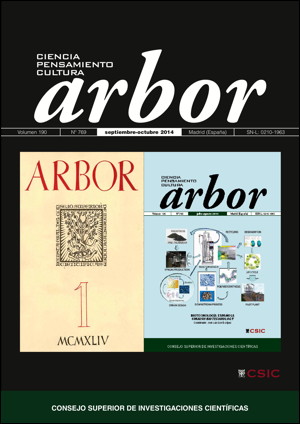Reflexiones sobre el miedo en el siglo XXI: filosofía, política, genética y evolución
DOI:
https://doi.org/10.3989/arbor.2014.769n5011Palabras clave:
Miedo, genética, evolución, heurística, hermenéuticaResumen
La actualidad y los acontecimientos de las últimas décadas han puesto de manifiesto la importancia del miedo en la vida pública. El miedo como tal y sus factores desencadenantes están presentes en la prensa, el discurso político, la neurociencia, la ciencia y la filosofía política. Entendemos que la gestión del miedo intuitivo, cognitivo y heurístico debe contemplarse como un elemento básico en la vida del ciudadano de este siglo. Tanto en la visión moderna de la nación y el contrato social, como en las visiones más futuristas de cosmopolitismo y estados supranacionales, la heurística del miedo difícilmente podrá desaparecer de los sistemas jurídicos y sociales, no solo por su utilidad intrínseca, sino también por su inmanencia y consubstancialidad genético-biológica y psico-social. El hecho de que exista miedo consideramos que es positivo puesto que nos alerta de riesgos que pueden afectar negativamente el futuro del individuo.
Descargas
Citas
Ayala, F. J. y Kiger, J. A. (1984). Modern Genetics (2nded.). Benjamin-Cummings Publishing Co.
Benito, C. y Espino, F. J. (2012). Genética. Conceptos esenciales. Madrid: Médica Panamericana.
Blanchard, D. C. y Blanchard, R. J. (1988). Ethoexperimental approaches to the biology of emotions. Annual Review of Psychology, 39, pp. 43-68. http://dx.doi.org/10.1146/annurev.ps.39.020188.000355
Bolles, R. C. (1970). Species-specific defense reactions and avoidance learning. Psychological Review, 77, pp. 32-48. http://dx.doi.org/10.1037/h0028589
Bourke, J. (2005). Fear: a cultural history. London: Virago Press.
Bracha, H. S. (2006).Human brain evolution and the 'Neuroevolutionarytime-depth principle'. Implications for the reclassification of fear-circuitry-related traits in DSM-V and for studying resilience to warzone-related posttraumatic stress disorder. Progress in Neuro-Psychopharmacology and Biological Psychiatry, 30, pp. 827-853. http://dx.doi.org/10.1016/j.pnpbp.2006.01.008
Bracha, H. S., Yoshioka, D. T., Masukawa, N. K. y Stockman, D. J. J. (2005). Evolution of the human fear-circuitry and acute sociogenic pseudoneurological symptoms: the Neolithic balanced-polymorphism hypothesis. Journal of Affective Disorders, 88, pp. 119-129. http://dx.doi.org/10.1016/j.jad.2005.05.013
Cano, M. y Vives-Rego, J.(2013). El ciudadano ecológico en los procesos de decisión social de la sostenibilidad: tecnociencia, ecoética y cosmovisión. Sociología y Tecnociencia, 4, pp. 38-57.
Fromm, E. (2005). El miedo a la libertad. Barcelona: Paidós.
Gauthier, D. (1969). The logic of Leviathan. Oxford: Oxford University Press.
Gordon, R. (1987). The structure of the emotion. Cambridge: Cambridge University Press.
Griffiths, A. J. F., Wessier, S. R., Lewontin, R. C. y Carroll, S. B. (2008). Genética (9ª ed). Madrid: Mc Graw Hill.
Hansberg, O. (1996). La diversidad de las emociones. México D.F.: Fondo de Cultura Económica.
Hettema, J. M. y Kendler, K. S. (2003). A twin study of the genetics of fear conditioning. Archives of General Psychiatry, 60, pp. 702-708. http://dx.doi.org/10.1001/archpsyc.60.7.702
Innerarity, D., y Solana, J. (2011). La humanidad amenazada: gobernar los riesgos globales. Barcelona: Paidós.
Jonas, H. (2004). El principio de la responsabilidad. Barcelona: Herder Editorial.
Klug, W. S., Cummings, M. R. y Spencer, C. A. (2006). Conceptos de Genética (8ª ed.). Madrid: Pearson – Prentice Hall.
Lacleau, E. y Mouffe, C. (1985). Hegemony and socialist strategy: towards a democratic radical democracy politics. London: Verso Books.
LeDoux, J. (1998). Fear and the brain: where have we been, and where are we going? Biological Psychiatry, 44, pp. 1229-1238. http://dx.doi.org/10.1016/S0006-3223(98)00282-0 http://dx.doi.org/10.1016/S0006-3223(98)00282-0
Mauthner, F. (2001). Contribuciones a una crítica del lenguaje. Barcelona: Herder.
Mineka, S. (1979).The role of fear in theories of avoidance learning, flooding and extinction. Psychological Bulletin, 86, pp. 985-1010. http://dx.doi.org/10.1037/0033-2909.86.5.985
Mineka, S. y Öhman, A. (2002). Phobias and preparedness: the selective, automatic, and encapsulated nature of fear. Biological Psychiatry, 52, pp. 927-937. http://dx.doi.org/10.1016/S0006-3223(02)01669-4
Mouffe, C. (1993). The return of the political. London: Verso Books.
Mouffe, C. (2000). The democratic paradox. London: Verso Books.
Nesse, R. M. (1990). Evolutionary explanations of emotions. Human Nature, 1, pp. 261-289. http://dx.doi.org/10.1007/BF02733986
Neufeld, J. (1991). Japan in flames. En: Nalty, B. C. (ed.). War in the Pacific. Pearl Harbor to Tokyo Bay. London, Salamander Books, pp. 268-283.
Olsson, A. y Phelps, E. A. (2007). Social learning of fear. Nature Neuroscience, 10, pp. 1095-1102. http://dx.doi.org/10.1038/nn1968
Panksepp, J. (1998). Affective Neuroscience: the foundation of human and animal emotions. New York: Oxford University Press.
Russell, P.A. (1979). Fear-evoking stimuli. En: Sluckin, W. (ed.). Fear in animals and man. New York: Van Nostrand Reinhold, pp. 85-124.
Sklahr, J. (1989). The liberalism of fear. En: Rosenblum, N. (ed.). Liberalism and the Moral Life. Harvard: Harvard University Press.
Strachan, T., y Read, A. P. (2010). Human molecular genetics (4thed.). New York: Garland Science Publishing.
Van Le, Q., Isbell, L. A., Matsumoto, J., Nguyen, M., Hori, E., Mayor, R. S., Tomaz, C., Than, A. H., Ono, T. y Nishijo, H. (2013). Pulvinar neurons reveal neurobiological evidence of past selection for rapid detection of snakes. Proceedings of the National Academy of Sciences, 110, pp. 19000-19005. http://dx.doi.org/10.1073/pnas.1312648110
Vives-Rego, J. (2010). Los dilemas medioambientales del siglo XXI ante la ecoética. Madrid: Bubok.
Vives-Rego, J. (2011). ¿Suicidio político o suicidio ecológico? Madrid: Fundamentos.
Vives-Rego, J. (2013). El ciudadano ecológico: reflexiones sobre algunos contextos sociales y elementos cosmovisionales. Sociología y Tecnociencia, 3, pp. 83-104.
Wanty. E. (1972). L'art de la guerre. Bruselas: Gerard and Co.
Zentner, J. (1969). Die Kriege der Nachkriegszeit. München: Su.dwestVerlag.
Zolo, D. (2009). Terrorismo umanitario. Dalla guerra del Golfo alla strage di Gaza. Reggio Emilia: Diabasis.
Publicado
Cómo citar
Número
Sección
Licencia
Derechos de autor 2014 Consejo Superior de Investigaciones Científicas (CSIC)

Esta obra está bajo una licencia internacional Creative Commons Atribución 4.0.
© CSIC. Los originales publicados en las ediciones impresa y electrónica de esta Revista son propiedad del Consejo Superior de Investigaciones Científicas, siendo necesario citar la procedencia en cualquier reproducción parcial o total.
Salvo indicación contraria, todos los contenidos de la edición electrónica se distribuyen bajo una licencia de uso y distribución “Creative Commons Reconocimiento 4.0 Internacional ” (CC BY 4.0). Consulte la versión informativa y el texto legal de la licencia. Esta circunstancia ha de hacerse constar expresamente de esta forma cuando sea necesario.
No se autoriza el depósito en repositorios, páginas web personales o similares de cualquier otra versión distinta a la publicada por el editor.














